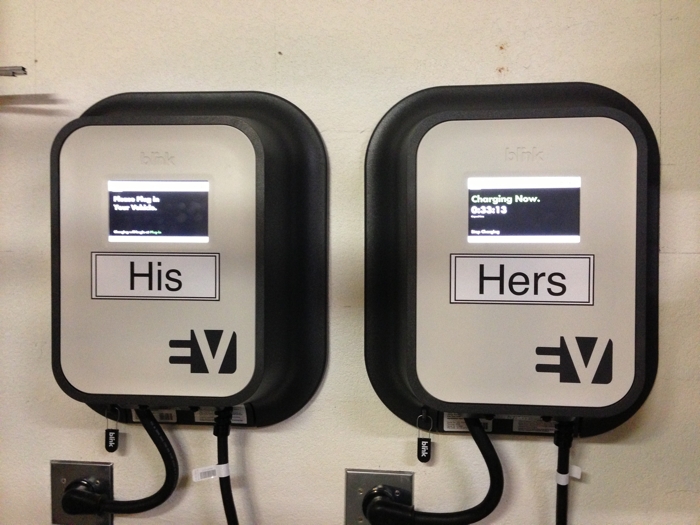I got the dreaded email regarding the Ecotality bankruptcy. As an owner of two Blink Level 2 charging stations, we have the right to pursue some sort of economic recompense for the loss of two years of our three year warranties.
Why bother? With creditors lining up, what possible money could be had by holders of now-defunct warranties? I should have seen this coming, but didn’t realize how much they were investing in the public charging network, compared to private installations like the one at my house.
We’ve talked about this before in Charging with Blink in the wild-cost effective? At the time I wrote that post, I had been pondering if I should invest in installing chargers in my area as a business opportunity. No matter how I ran the numbers, it just didn’t make sense. One of the advantages of electric vehicles is how inexpensive their fuel is. However, that very advantage turns into a disadvantage for those wanting to provide that fuel (electricity).
For the time being, home chargers are going to be the way to go. Some car manufacturers (like Tesla) may have enough of an environmental conscience (or profit margin) that they are motivated (and can afford) to create a network of chargers and provide the energy at no charge (or at their cost), making the network and their primary product (electric vehicles) viable. I have to admit, I like that Tesla is using solar panels to provide the electricity. Nissan is reported to be providing a loan to Ecotality to fund the company long enough for it to divest itself of its assets. Perhaps this is a way for Nissan to establish a network of chargers for pennies on the dollar. These are critical issues for fully electric vehicles that are not much of a concern for drivers of plug-in hybrids like the Chevy Volt. Although I HATE when I have to resort to gasoline, at least I’m not driving around frantically watching the “electric miles remaining” display, wondering if I’m going to make it to my destination or the next charger.
This is a pressing issue. How will EVs ever reach the tipping point of widespread acceptance, if apartment dwellers can’t charge at home and there are no public charging networks to serve them? Are they supposed to depend on their employers providing chargers and free electricity (or at least electricity at their cost?)?
What are your thoughts about a way to implement a public charging network that can work financially? I’m calling on you all to provide some answers!
**UPDATE**
A funny thing happened the next morning. For those of you who are fans of Big Bang Theory, you probably know from where the quote in the title of this post originated. For those who don’t enjoy BBT, the quote is from Dr. Sheldon Cooper (played by Emmy Award-winning actor, Jim Parsons) one of the main characters in the show. I was checking email on my iPhone, the morning after the blog post and found this announcement (see below). For a short moment there, I was very excited!


Great question, I can’t think of a way to make money in public charging. Unlike gasoline, electricity as a fuel does not need to happen away from home. The volume of drivers needing public charging will will only ever be a small fraction of what gasoline stations have. At 40 miles per day on average, a 16kwh battery with current technology is enough to only need to charge at home. EV’s are quickly becoming more efficient, providing even more range. On holidays, public charging will be highly utilized for longer trips, but most days, most people won’t use them. I see apartments installing stations as an ammenity. The future I see is an integration into public roads and bridges, like street lamps. Maybe the electrified road idea is the way to go.
I’ve thought the charger as an upscale amenity would happen too, but it’s a chicken-and-egg thing. Adoption rates are going to have to go up in groups that may choose to live in apartments, but I think they’ll hold off until the charging situation is resolved. Apartments won’t see a real benefit (rent premiums or higher occupancy rates) from charger installation unless their demographic needs them.
I think forward-thinking businesses and apartment managers will take the plunge first, especially if the business or apartment complex owners switch to EVs. They’ll see it as an environmental necessity or civic duty and if enough of these groups take the plunge, drivers will follow.
I’d like to see chargers outside of businesses that make sense to have them, like movie theaters, hotels/motels, airports (with valets to rotate parked cars through the chargers), sports venues (premium parking), etc. Places where people will stay for a few hours. Near me there are chargers at a McDonalds. I tried that, when I first got my Volt, but who wants to hang out at McDonalds for four hours?
Good question. But, to start with, reczonige that twhatever we do,it will be agradual transition. Electric cars will be on the market before the end of the decade but only a few thousand a year at first and then build up volume over time. So there’s time to build new power generating plants.But there are other options than just large (traditional technology) power plants. To take one example, solar power (I’ll use this because its the one I know best but here are others: wind, tidal, geothermal,etc).In California, more power is already needed and soon. But solar power can supply (estimates) up to 30% of the demand and even more of the peakdemand (that occurs when its hot and sunny when solar is at its most efficient). That’s a BIG chunk of the power requirements. And it has the advantage that it can be buildt quickly installing solar panels takes days, not years and as market demand builds (its already rising rapidly) the scale of new power generation rises with it. Point is, we get the power starting more or less immediately.The real key is going to be developing an infrastructure that “caters” to electric cars the way our oil/gas/service station industry caters to gasoline powered cars now. And that will take time but again, it will be years before we have enough electric cars to matter, so in a sense its a “self-correcting” problem. Someof this infrastructure is already under development. Here’s one model of how some of that infrastructure might work in practice (and, for the sake of arguement, assume its all solar power, weather permitting):You’ve left your car plugged in to recharge sunday afternoon after the family got pack from church. So, Monday morning, its at full charge. But bad news the traffic is a mess, so by the time you get to work, you’re down to half charge. No problem. The owner of the parking deck (enterprising soul) has installed sollar arrays on the roof and plug-ins (with meters to tote up the fees) for customers. You park plug in your car and its recharged long before you get off work. And the rest of the week works pretty much the same. It’s not a 100% solar system but 80% of your power at home and from your car comes from solar panels and while paying for those home solar panels was a push a few years before, they’ve long since returned the investment in lower energy costs. Between that ant the savings on transportation (even the electricity you buy from the parking concession is cheaper than gas used to be) you pay half for energy you did in 2007.Granted, this may take 20 years but that or something similar is the way things are headed. Almost makes you feel sorry for the oil companies. Almost!
Buzz, good article! I like to tell people that third party ownership of EV charging station is a fantastic business model…in the year 2020. Most likely only for DC fast charging, however. The benefits of public Level 2 charging stations really accrue to the site host, but not really to the station owner (if the two are different entities). Take Kohl’s for example. Their EV drivers spend on average $20 more per visit than their non-EV drivers. The charging station, and free electricity, act like any other amenity.